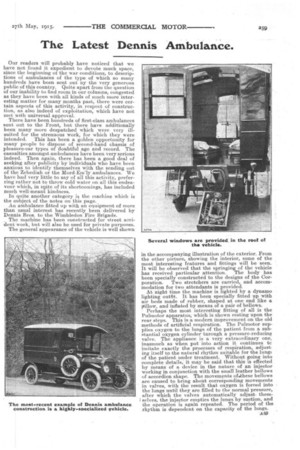The Latest Dennis Ambulance.
Page 15

If you've noticed an error in this article please click here to report it so we can fix it.
Our readers will probably have noticed that we have not found it expedient to devote much space, since the beginning of the war conditions, to descriptions of ambulances of the type of which so many hundreds have been sent out by the very generous public of this country. Quite apart from the question of our inability to find room in our columns, congested as they have been with all kinds of much more interesting matter for many months past, there were certain aspects of this activity, in respect of construction, as also indeed of exploitation, which have not met with universal approval. There have been hundreds of first-class ambulances sent out to the Front, but there have additionally been many more despatched which were very
illsuited for the strenuous work, for which they were intended. This has been a golden opportunity for many people to dispose of second-hand chassis of pleasure-car types of doubtful age and record. The casualties amongst ambulances have been very serious indeed. Then again, there has been a good deal of seeking after publicity by individuals who have been anxious to identify themselves with the sending out of the Zebediah or the Mord-D.11'1y ambulances. We have had very little to say of all this activity, preferring rather not to throw cold water on all this endeavour which, in suite of its shortcomings, has included much well-meant kindness.
In quite another category is the machine which is the subject of the notes on this page.
An ambulance fitted up with an equipment of more than usual interest has recently been delivered by Dennis Bros. to the Wimbledon Fire Brigade. The machine has been constructed for street accident work, but will also be used for private purposes. The general appearance of the vehicle is well shown in the accompanying illustration of the exterior. From the other picture, showing the interior, some of the most interesting features and fittings will be seen. It will be observed that the springing of the vehicle has received particular attention. The body has been specially constructed to the designs of the Corporation. Two stretchers are carried, and accommodation for two attendants is provided. At night time the machine is lighted by a dynamo lighting outfit. It has been specially fitted up with air beds made of rubber, shaped at one end like a pillow, and inflated by means of a pair of bellows.
Perhaps the most interesting fitting of all is the Pulmotor apparatus, which is shown resting upon the rear steps. This is a modern improvement on the old methods of artificial respiration. The Pulinotor supplies oxygen to the lungs of the patient from a substantial oxygen cylinder through a pressure-reducing valve. The appliance is a very extraordinary one, inasmuch as when put into action it continues te imitate exactly the processes of respiration, adjusting itself to the natural rhythm suitable for the lungE of the patient under treatment. Without going into complete details, it may be said that this is effected by means of a device in the nature of an injector working in conjunction with the small leather bellows of accordion shape. The movements of.these bellows are caused to bring about corresponding movements in valves, with the result that oxygen is forced into the lungs until they are filled to the normal pressure, after which the valves automatically adjust themselves, the injector empties the lungs by suction, and the operation is again repeated. The period of the rhythm is dependent on the capacity of the lungs.




















